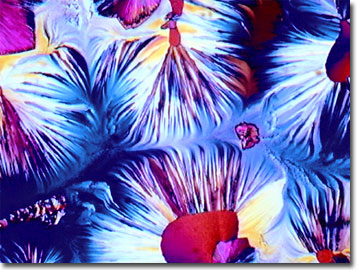Polarized Light Digital Image Gallery
Calcium Chloride
A colorless or white solid, calcium chloride is well known for its anhydrous properties, with the capacity of absorbing more than its own weight of water. The inorganic crystalline compound is commonly employed as a drying agent and is often featured in small packets as packing for moisture-sensitive electronics and other products.

View a second image of crystallized calcium chloride.
As a by-product of the Solvay chemical process for manufacturing sodium carbonate, calcium chloride can also be synthesized directly by reacting hydrochloric acid with calcium carbonate. In addition to its common use as a drying agent, calcium chloride is used in oil and gas drilling, dust control for unpaved roads, road base stabilization, ready-mix concrete acceleration, gas drying, tractor tire weighting, brine refrigeration, food preservation, and an extender for rock salt used for deicing winter roads. For marine aquariums, the high solubility of calcium chloride makes it a great source of calcium for calcifying organisms such as corals and oysters. Safer for freshwater aquatic ecosystems and vegetation than sodium chloride, calcium chloride (in a corrosion-inhibited formulation) can melt ice at temperatures of minus 25 degrees Fahrenheit, well beyond regular salt's range.
Once a waste product, but now marketed under several brand names, calcium chloride has a pH between 8 and 9 when dissolved into aqueous solution, a melting point of 772 degrees Celsius, and a boiling point of more than 1,600 degrees Celsius. Caution is needed in some cases because metals will slowly corrode when exposed to aqueous calcium chloride solutions. In particular, this calcium salt aggressively attacks yellow brass and aluminum and its alloys. As a source of elemental calcium (which does not occur in nature), the electrolysis of molten calcium chloride creates calcium for commercial purposes.
Contributing Authors
Omar Alvarado, Thomas J. Fellers and Michael W. Davidson - National High Magnetic Field Laboratory, 1800 East Paul Dirac Dr., The Florida State University, Tallahassee, Florida, 32310.
BACK TO THE POLARIZED LIGHT IMAGE GALLERY
BACK TO THE DIGITAL IMAGE GALLERIES
Questions or comments? Send us an email.
© 1995-2025 by Michael W. Davidson and The Florida State University. All Rights Reserved. No images, graphics, software, scripts, or applets may be reproduced or used in any manner without permission from the copyright holders. Use of this website means you agree to all of the Legal Terms and Conditions set forth by the owners.
This website is maintained by our
Graphics & Web Programming Team
in collaboration with Optical Microscopy at the
National High Magnetic Field Laboratory.
Last Modification Friday, Nov 13, 2015 at 01:19 PM
Access Count Since September 17, 2002: 16340
Visit the website of our partner in introductory microscopy education:
|
|
